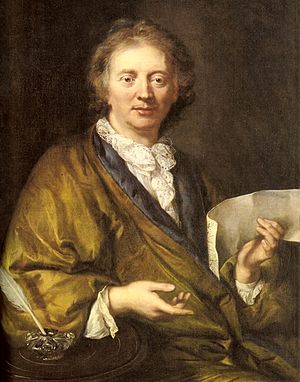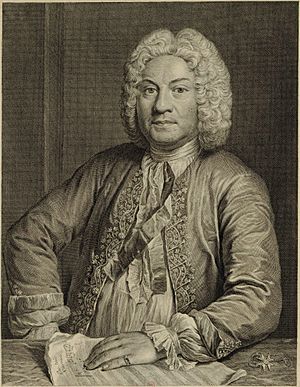François Couperin facts for kids
François Couperin (born November 10, 1668 – died September 11, 1733) was a famous French composer, organist, and harpsichord player. He lived during the Baroque period of music. People called him Couperin le Grand, which means "Couperin the Great". This helped tell him apart from other talented musicians in his Couperin family.
Contents
Life of François Couperin
François Couperin was born in Paris, France. He came from a very musical family. His father, Charles, was the organist at the Church of Saint-Gervais. Before Charles, his uncle Louis Couperin held the same job. Louis was a very skilled keyboard player and composer.
François likely learned music from his father first. But Charles died in 1679. This left the organist job at Saint-Gervais open. It was common then for a son to take over his father's job. This was called survivance. The church hired Michel Richard Delalande as a temporary organist. They agreed that François would take over when he turned 18.
However, François probably started playing earlier. He received a small payment that grew over time. This suggests he began his duties as he got older. Meanwhile, Jacques Thomelin, an organist for the king, taught the 11-year-old François. Thomelin was very kind to him, like a second father. François's talent was clear early on. By 1685, the church started paying him a salary.
Early Career and Family Life
When he was 21, Couperin's mother, Marie, also passed away. But otherwise, his life was quite lucky. In 1689, he married Marie-Anne Ansault. Her family was quite wealthy. The next year, he published his Pièces d'orgue. This was a collection of organ masses. Even Delalande, the temporary organist, praised them.
Three years later, Couperin got a job at King Louis XIV's court. This meant he met many great composers and important people. His first chamber music pieces are from this time. He balanced his court duties with his job at Saint-Gervais. He also continued to compose new music.
Publishing Music and Royal Recognition
In 1713, Couperin received a special permission from the King. This allowed him to publish many of his musical works. He immediately used it to release the first of four books of his harpsichord music. These were called Pieces de clavecin.
In 1716, he published L'art de toucher le clavecin. This was a guide on how to play the harpsichord. It was later re-released in 1717. He also published other collections of keyboard and chamber music. In 1717, Couperin received a very high position. He became the King's harpsichord player. This was a job once held by Jean-Henri d'Anglebert.
Later Years and Legacy
Couperin's health began to get worse in the 1720s. By 1723, a cousin had to help him at Saint-Gervais. In 1730, his daughter, Marguerite-Antoinette Couperin, took over his court harpsichord job. Couperin's last published works were Pièces de violes (1728) and his fourth book of harpsichord pieces (1730). He passed away in 1733.
The building where Couperin and his family lived still stands today. It is in Paris, at the corner of rue Radziwill and rue des Petits Champs. He had at least three children who survived him. Marguerite-Antoinette continued as the court harpsichordist. Marie-Madeleine became a nun and organist. His son, François-Laurent, left the family after his father died.
Musical Works of Couperin
Couperin admired the Italian composer Arcangelo Corelli. He brought Corelli's trio sonata style to France. A trio sonata is a piece for two solo instruments and a bass instrument. Couperin wrote two important trio sonatas.
One was Le Parnasse, ou L'Apothéose de Corelli. This means "Parnassus, or the Apotheosis of Corelli". He published it in 1724. It showed his great respect for Corelli. The other was L'Apothéose de Lully, published a year later. This honored Jean-Baptiste Lully, another famous composer.
This piece mixed French and Italian Baroque music styles. Couperin called this a réunion des goûts, meaning "a reunion of tastes". In the same year, he published "Nouveaux concerts, ou Les goûts réunis". This set of ten pieces also combined these two styles.
Harpsichord Music
Couperin's most famous book is L'art de toucher le clavecin. This means "The Art of Harpsichord Playing". It was published in 1716. The book gives tips on how to use your fingers, how to touch the keys, and how to add musical decorations. It also has eight preludes. These are short pieces that introduce the keys of his first two harpsichord books.
Couperin wrote four books of harpsichord music. They were published in Paris in 1713, 1717, 1722, and 1730. These books contain over 230 individual pieces. He also published Concerts Royaux. These can be played alone on the harpsichord or with a small group of instruments.
His harpsichord collections are grouped into ordres. This is another word for suites. Suites are collections of dance movements. Couperin was very detailed about how to play the ornaments. Ornaments are musical decorations. In most music of that time, players decided how to add them.
The first and last pieces in an ordre were in the same key. But the middle pieces could be in related keys. Famous composers like Johann Sebastian Bach admired these works. Later, Johannes Brahms and Maurice Ravel also liked them. Ravel even wrote a piece called Le Tombeau de Couperin (Couperin's Memorial) to honor him.
Many of Couperin's keyboard pieces have fun, descriptive titles. Examples include "The little windmills" and "The mysterious barricades". They create a mood using different keys and interesting harmonies. They are like tiny musical poems. Composer Richard Strauss even arranged some of them for an orchestra.
Johannes Brahms was influenced by Couperin's keyboard music. Brahms played Couperin's music in public. He also helped with a new edition of Couperin's Pièces de clavecin in the 1880s. The modern English composer Thomas Adès also used three of Couperin's pieces. He arranged them for orchestra in his work "Three Studies from Couperin".
Music expert Jordi Savall called Couperin the "poet musician". He believed music could express itself like poetry. Savall said that if we understand the poetry of music, we find a beauty that is "more beautiful than beauty itself".
Organ Music
Only one collection of Couperin's organ music still exists. It is called Pièces d'orgue consistantes en deux messes. This means "Pieces for Organ Consisting of Two Masses". They were published in November 1690. Couperin was only 21 at the time. He probably did not have much money or fame to publish widely. So, the masses were released as handwritten copies.
His teacher, Michel Richard Delalande, praised the music. He wrote that it was "very beautiful and worthy of being given to the public." The two masses were for different places. The first was for churches in towns. The second was for convents or abbey churches.
These masses have many movements. They follow the traditional parts of a Latin Mass. These include Kyrie, Gloria, Sanctus, and Agnus. Each mass also ends with an Offertoire and Deo gratias.
Couperin used techniques from earlier French Baroque composers. For example, in the first Mass, he used Gregorian chant melodies. These were from a specific chant called Missa cunctipotens genitor Deus. He used them in some Kyrie and Sanctus movements. The second Mass did not use plainchant. This is because each convent had its own unique chants.
Couperin also changed some things from earlier composers. For example, his Récits (solo melodies) were more rhythmic. Music historian Willi Apel said this music brought "a fresh wind" to French organ music.
The longest piece in the collection is the Offertoire sur les grands jeux from the first Mass. It is like a long French overture. It has three main parts: a prelude, a chromatic fugue, and a gigue-like fugue. Music expert Bruce Gustafson called it a "stunning masterpiece." The second Mass also has an Offertoire. But it is not considered as great as the first.
See also
 In Spanish: François Couperin para niños
In Spanish: François Couperin para niños
- French organ school
- Marguerite-Antoinette Couperin (1705–1778), Francois Couperin's daughter



